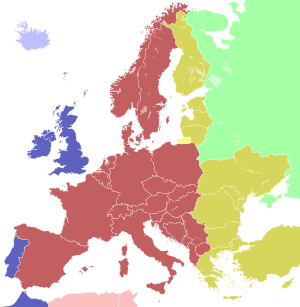Further-eastern European Time

| light blue | Western European Time (UTC+0) |
| blue | Western European Time (UTC+0) Western European Summer Time (UTC+01:00) |
| pink | Central European Time (UTC+01:00) |
| red | Central European Time (UTC+01:00) Central European Summer Time (UTC+02:00) |
| yellow | Kaliningrad Time (UTC+02:00) |
| golden | Eastern European Time (UTC+02:00) Eastern European Summer Time (UTC+03:00) |
| light green | Minsk Time, Moscow Time (UTC+03:00) |
Further-eastern European Time (FET) is the name of a time zone in Europe between Eastern European Time and Moscow Time or same as one of them. After October 2014 it is used only in Belarus, and is also called Minsk Time. It is since 2011 defined as three hours ahead of UTC (UTC+03:00) without daylight savings time. It was established in October 2011 as the official time for the in Kaliningrad Oblast in Russia, and then followed by Belarus. It was called Kaliningrad Time in Russia. In October 2014 most of Russia moved the UTC offset back one hour. This means that Kaliningrad Time is UTC+02:00. From that date the term Minsk Time is preferred instead of Further-eastern European Time, but also Moscow Time, which from 2014 is the same as Minsk time, UTC+03:00.
History
Until 2011, Further-eastern European Time was identical to Eastern European Time (UTC+2; UTC+3 with daylight saving time). However, on 27 March 2011, Russia moved to the so-called "year-round daylight saving time",[1] so that clocks would remain on what had been the summer time all year round, making Kaliningrad Time permanently set to UTC+3, peculiarly placing its time ahead of countries to its east during winter. Belarus followed Russia on 15 September 2011,[2] and the same decision was made by the Ukrainian parliament on 20 September 2011.[3] After strong criticism from the mass media, on 18 October 2011 the Ukrainian parliament cancelled its previous decision.[4] Transnistria, a breakaway territory from Moldova on the Dniester river bordering Ukraine, followed Ukraine by at first adopting Further-eastern European Time[5] but later cancelling this decision.[6]
The name "Further-eastern European Time" seems to have come from work on the tz database.[7][8][9]
See also
- Time zone
- UTC+03:00
- Time in Ukraine (Kiev Time)
References
- ↑ Russia Time Change
- ↑ Eternal Daylight Saving Time (DST) in Belarus
- ↑ Ukraine cancels use of daylight saving time, Kyiv Post (September 20, 2011)
- ↑ "Ukraine to return to standard time on Oct. 30 (updated)". Kyiv Post. 18 October 2011. Retrieved 18 October 2011.
- ↑ Transnistria stays on Daylight Saving Time
- ↑ Transnistria's clocks move back October 30, 2011
- ↑ Tim Parenti and Paul Eggert (Sep 20, 2011). "Ukraine adopts UTC+3 year-round". Retrieved 1 Dec 2011.
- ↑ Alexander Bokovoy, employed at Red Hat Software (Sep 21, 2011). Дальневосточное Европейское время (in Russian). Retrieved 16 Oct 2011.
- ↑ Edwin Groothuis, at freebsd.org (27 Sep 2011). "cvs commit: ports/misc/zoneinfo Makefile distinfo". Retrieved 16 Oct 2011.